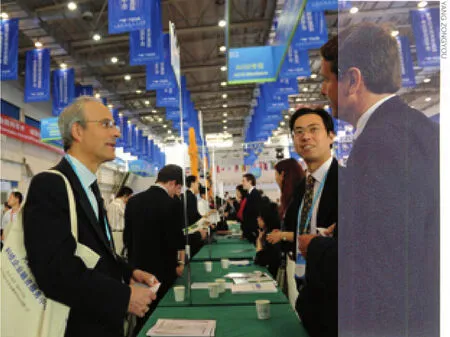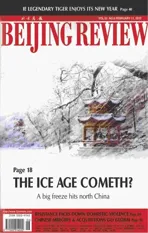FDI Destination
2010-03-15LANXINZHEN
China tops investment list as the Central Government continues to create an attractive environment for foreign investors
By LAN XINZHEN
For the past few years, China has topped the list of U.S. management consulting firm A.T. Kearney’s Foreign Direct Investment Confidence Index. On January 25, the consulting firm issued its latest index, which showed China was still the world’s most attractive investment destination.
A.T. Kearney issues a report every year on global investment flows. Analyzing opinions from presidents of 1,000 major multinational companies throughout the world, the report is commonly recognized by the international community as an indicator of comprehensive attraction of investment environments in various countries.
In 2009, some foreign companies withdrew from China’s coastal areas, causing some people to worry China would be less appealing to foreign investors. The A.T. Kearney report indicates such worries are unnecessary.
In fact, China’s appeal to foreign investment is not declining. According to figures released by the United Nations Conference on Trade and Development on January 19, 2010, the paid-in capital in China reached $90.03 billion in 2009, a decline of only 2.6 percent, while the paidin capital worldwide dropped 39 percent in the same period. In 2009, China ranked second in absorbing foreign investment,just following the Untied States.
“Even under such grave circumstances,there was still $90 billion in foreign investment entering China. What does this mean? It means that the expanding Chinese market is very attractive, that the Chinese investment environment is being improved, and that Chinese legal construction is in progress,” said Ma Jiantang, Commissioner of the National Bureau of Statistics (NBS). “I believe that the huge Chinese market and the improved investment environment have great attraction for any company that wants to develop.”
Among figures released by the NBS on foreign direct investment (FDI) in 2009, one interesting phenomenon stands out. In January and February 2009, China-attracted FDI decreased 26.2 percent year on year, but in December that year, the paid-in capital soared 103.1 percent from the year before.
Policies in 2010
Although investors will always have their complaints, it is undeniable the Chinese Government has created a good investment environment for foreign investors.
Against the backdrop of FDI decrease throughout the world, Chinese Premier Wen Jiabao held a State Council meeting on December 30, 2009 to implement further measures to attract foreign investment.
According to policymakers at the meeting, foreign-invested companies have become an important part of the national economy and China should create an investment environment that is more open and more optimized.
The meeting put forward five aspects to attract foreign investment in 2010∶ Revising the Catalogue of Industries for Guiding Foreign Investment so as to expand the fi elds for opening up; rendering priority land supply to projects in land-intensive industries where foreign investment is encouraged by the country; encouraging foreign investors to participate in reorganizing and transforming domestic enterprises by means of mergers and acquisitions; expanding fi nancial channels in China for foreign-invested companies and guiding fi nancial institutions to further enlarge credit support to foreign-invested companies; and improving the foreign exchange administration of foreign-invested companies and simplifying the settlement proceedings of their foreign exchange capitals.
Yao Jian, spokesman for the Ministry of Commerce (MOFCOM), said the detailed new policies for attracting foreign investment are being researched and formulated.“Attracting foreign investment in various forms is an important part of our research.With a short supply of land resources and accelerated industrial upgrading in China, webelieve there will be more and more mergers and acquisitions,” he said.

(left) A GOOD HOME FOR INVESTMENT: A groundbreaking ceremony is held for the Chang’an Ford Mazda Automobile Chongqing Plant on September 25, 2009

ENTHUSIASTIC INVESTORS:Investors from various countries look for investment projects in China at the Third China International Private Equity Forum held in Tianjin on June 10, 2009
China is creating a conducive environment to promote mutual bene fi t and common development between itself and the world beyond, while providing services to transnational companies, Yao said.
Economists are also optimistic concerning China’s ability to attract foreign investment in 2010.
Sang Baichuan, a professor at the School of International Trade and Economics of the University of International Business and Economics, thinks since China has adopted a series of measures to expand domestic demand and accelerate economic structural readjustment, rare opportunities for international investors to enter the Chinese market will present themselves. In the meantime,China is actively strengthening its efforts to save energy, reduce wastes emissions and develop a low-carbon economy, which can effectively increase the investment returns rate and attract investments from countries with advantages in the low-carbon economy.
More importantly, as an important economy of sustained growth among a number of economies throughout the globe still recovering,China has a substantial attraction to transnational companies. Most transnational companies are also fi rmly optimistic about the Chinese market and investment prospects.
“Seven hot industries, such as new energy, clean technologies and biopharmaceutics, will be the first choice of investors,”Sang said.
Challenges still exist
Although transnational companies are firmly optimistic about the Chinese market and its investment prospects, and while some transnational companies call the Chinese economy the world’s best, China still faces many challenges in attracting foreign investment under current global economic conditions.
According to Sang, influenced by the global financial crisis, capital chains from some transnational companies are tight and even split, weakening their investment capabilities. Therefore many are tightening their investment arrangements and industrial chains, or drawing back investment.
As the world economy developed, a global industrial labor division was formed∶East Asia became the supplier of parts and components, China was the processing and manufacturing base, while European countries and the United States were researchers and developers of core technologies as well as the major markets. The result was a trade surplus by some Asian countries to those in the West. Currently, the trade surplus of China to Europe and the United States is expanding and trade frictions are exacerbated.China’s exporting environment has declined,which in turn has caused some export-oriented foreign-invested companies to retreat.
As competition between foreign-invested and domestic-funded companies heats up,some less competitive foreign-invested companies may withdraw from China.
According to Sang, another challenge that cannot be ignored is China has entered an era of climbing costs. Renminbi (yuan) appreciation has led to hikes of capital and real estate prices, and rises in exporting costs. Social and economic development will inevitably increase labor costs. The rise of such costs will weaken the international competitiveness of exported products by foreign-invested companies, which will accelerate the regional transfer of FDI.
“The influence of rising costs will be first reflected in low-end industries, such as laborintensive industries. China’s comparative advantages are gradually weakened and the country is facing challenges from neighboring countries, such as Viet Nam and Malaysia, in attracting foreign investment,” Sang said.
Sang suggests that China focus on strategic innovations in utilizing foreign investment.“Facing the changing world economic situation and international FDI environment, China should grasp the opportunities presented by the world economic recovery and utilize its large-scale foreign exchange reserves. Marked improvements can be made in its corporate overseas investment capabilities to be bold in their overseas investments and resolute in transnational mergers and acquisitions,” Sang said. “On the other hand, China should actively attract international investment during the process of developing a low-carbon economy,industrial reorganization and expanding service trade.” ■
